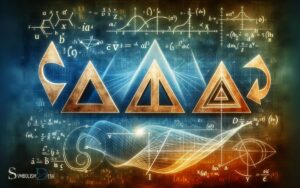Symbol for or in Math: Disjunction
The symbol for “or” in mathematics is represented by the logical disjunction symbol “∨”. This symbol is used in various branches of mathematics including set theory, logic, and probability.
In mathematics, the “∨” symbol denotes a logical operation between two statements, indicating that at least one of the statements is true.
For example: A ∨ B
This expression means that either statement A is true, or statement B is true, or both are true.
Here are some key points regarding the “or” symbol in math:
The “∨” symbol is a cornerstone of logical expressions and plays a crucial role in mathematical reasoning and proof formulation.

Key Takeaway
Understanding the “OR” Symbol in Mathematics: Logical Disjunction
| Symbol | Name | Operation | Example | Field of Use |
|---|---|---|---|---|
| ∨ | Logical OR | Disjunction | A ∨ B | Logic, Set Theory |
| ∪ | Union | Combination of sets | A ∪ B | Set Theory |
| + | Plus | Addition | A + B | Arithmetic |
| × | Times | Multiplication | A × B | Arithmetic |
| ⊕ | Exclusive OR | Either, but not both | A ⊕ B | Logic, Electronics |
Historical Significance of Mathematical Symbols
The historical significance of mathematical symbols is evident in the evolution of mathematical notation throughout various cultures and time periods. Mathematical symbols have played a crucial role in the development and communication of mathematical ideas.
The earliest mathematical symbols can be traced back to ancient civilizations such as the Babylonians, Egyptians, and Greeks, who used symbols to represent numbers, operations, and geometric shapes.
These early symbols laid the foundation for the modern mathematical notation system that we use today. As mathematics advanced, so did the need for more sophisticated symbols to express complex concepts.
The development of symbols such as the equals sign, square root symbol, and the integral symbol revolutionized mathematical communication and problem-solving.
Understanding the historical significance of mathematical symbols provides insight into the evolution of mathematical thought and the universal language of mathematics.
Types of Mathematical Symbols
In mathematics, the use of symbols for and in equations is essential for representing various operations and relationships. Mathematical symbols can be categorized into different types based on their functions and meanings. These symbols serve as a universal language, enabling mathematicians and students worldwide to communicate complex ideas efficiently. For instance, the “+” symbol represents addition, while “=” indicates equality between expressions. The symbol for and in math, often represented by ∧ in logic, signifies conjunction, where two statements are simultaneously true.
One type includes arithmetic symbols such as + (addition), – (subtraction), × (multiplication), and ÷ (division), which are used to denote basic mathematical operations.
Another type comprises relational symbols like = (equal to), ≠ (not equal to), < (less than), and > (greater than), which are used to express relationships between quantities.
There are also symbols for representing sets, such as ∈ (is an element of) and ∉ (is not an element of), as well as symbols for representing functions and variables.
Understanding the types of mathematical symbols is crucial for effectively interpreting and manipulating mathematical expressions.
Operations and Functions Represented by Symbols
Moving from the categorization of mathematical symbols, the representation of operations and functions using specific symbols is integral to mathematical expressions.
Mathematical operations such as addition, subtraction, multiplication, and division are commonly denoted by symbols like “+”, “−”, “×”, and “÷” respectively.
These symbols streamline the communication of mathematical processes, allowing for concise and unambiguous expressions.
Additionally, functions in mathematics are represented by symbols such as “f(x)” or “g(x)”, where “x” is the input and “f(x)” or “g(x)” represents the output.
These symbols are essential for denoting the relationship between variables and are fundamental in various mathematical disciplines.
Overall, the use of specific symbols for operations and functions facilitates the clear articulation and manipulation of mathematical concepts and calculations.
Notable Mathematical Constants and Their Symbols
Notably, mathematical constants such as π and e are widely recognized for their significance in various mathematical contexts.
Frequently, these constants are represented by specific symbols that succinctly convey their values and roles in mathematical equations and formulas.
| Constant | Symbol | Value |
|---|---|---|
| π | π | 3.14159265359… |
| e | e | 2.71828182846… |
| φ | φ (phi) | 1.61803398875… |
| γ | γ (gamma) | 0.57721566490… |
These symbols serve as a shorthand for these essential constants, enabling mathematicians to efficiently work with them in various mathematical expressions and calculations.
Evolution of Mathematical Notation
Frequently, the evolution of mathematical notation has been influenced by the need for clearer and more efficient representation of mathematical concepts and operations.
This evolution has been driven by various factors, including:
- Cultural Influences: The notation used in mathematics has been shaped by the cultures and societies in which it developed, leading to diverse symbols and representations.
- Advancements in Technology: The advent of computing and digital communication has influenced the development of mathematical notation, leading to the use of symbols that are easily transcribed and manipulated in digital environments.
- Interdisciplinary Collaboration: Collaboration between mathematicians and practitioners in other fields has led to the adaptation and evolution of mathematical notation to accommodate a wider range of applications and contexts.
Conclusion
The evolution of mathematical notation has played a crucial role in the development of mathematical thought and communication.
One interesting statistic is that there are over 100 different mathematical symbols commonly used in various branches of mathematics, highlighting the complexity and depth of the field.
This rich history and variety of symbols continue to be essential for the advancement of mathematical knowledge and problem-solving.






